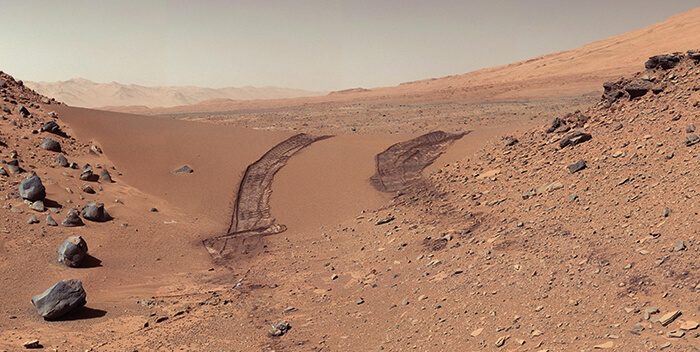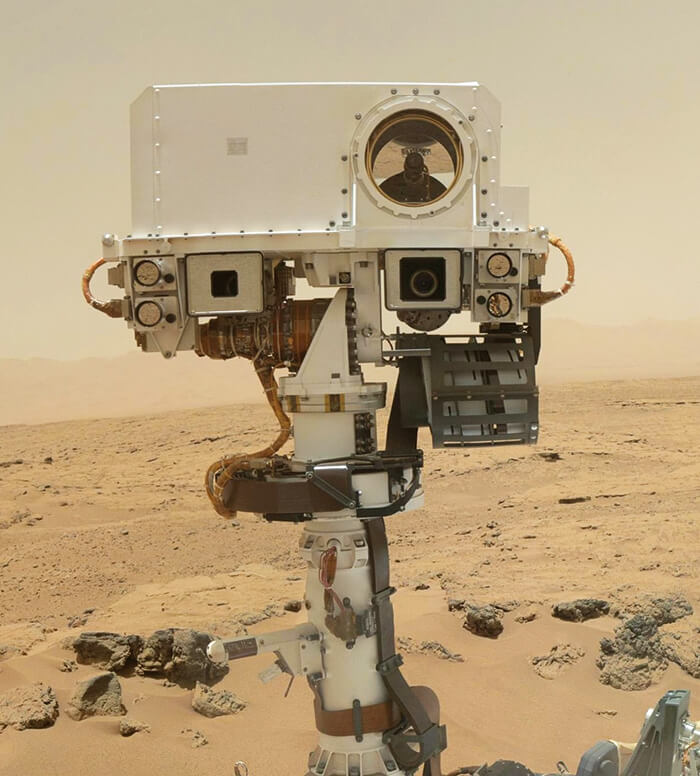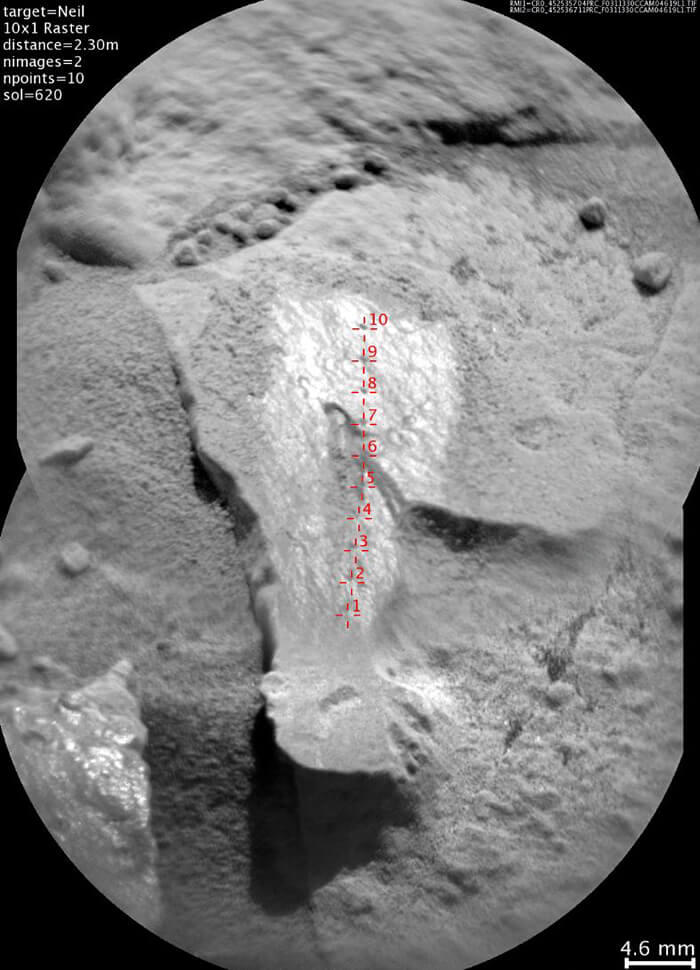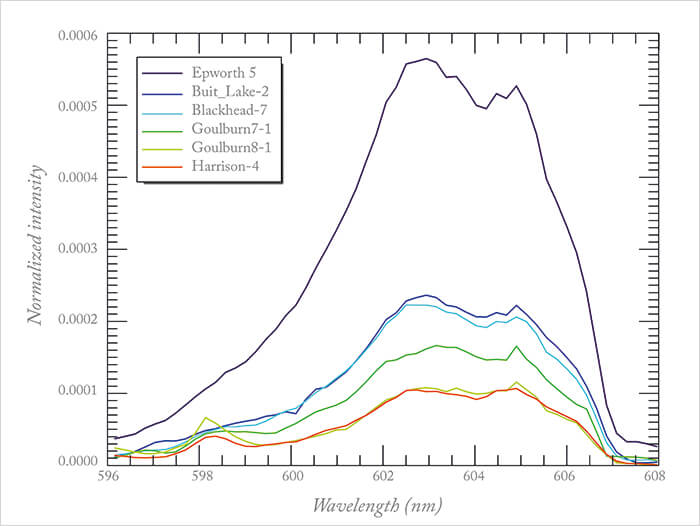
Roger Wiens, ChemCam Principal Investigator for the Mars Science Laboratory Rover at North America’s Los Alamos National Laboratory in New Mexico, shares his experiences in extraterrestrial analytical science.
That’s difficult to answer because Curiosity has completely revolutionized our understanding of Mars in a number of ways. She has discovered organic molecules including methane; we have seen the first extra-terrestrial riverbed rocks (conglomerates) as well as sandstones and mudstones formed at the bottom of a large lake. ChemCam specifically discovered that fine-grained Martian soils and wind-blown dust are hydrated. ChemCam also discovered a type of lower-density rock more reminiscent of those common on the terrestrial continents – more aluminium- and silicon-rich than were thought to exist in large quantities on Mars. We have also seen evidence of highly varying oxidation states in Mars’ ancient groundwater.

Miniaturization of instruments is the key to deploying them in the field, whether on Earth or on Mars. ChemCam leads the way in terms of applying LIBS to study field geology; similarly, there are now portable x-ray fluorescence (XRF) spectrometers that were inspired by the APXS (alpha particle x-ray spectrometer) instrument, now on its third generation of rover. Miniature gas chromatographs (GCs), similar to that on the SAM (comprising a quadrupole mass spectrometer, a GC, and a tunable laser spectrometer) instrument, are now available, and the same is true of field-portable x-ray diffraction instruments, thanks to the Chemistry & Mineralogy team.

We’re living in an increasingly robotic world. So many of our activities on Earth, from astronomical observations to harvesting crops, are done more and more robotically. Exploring Mars robotically encourages us to take new steps in technology here at home. But, we can’t always measure the value of science by immediate benefits. Our understanding of Mars is important for longer-term benefits, whether it helps us understand climate change on Earth or leads to very long-term terraforming of our neighboring planet.


A revolutionary rover. A thrilling space exploration. A tale of human ingenuity and ground-breaking engineering…
In Red Rover, Roger Wiens paints an engaging and highly personal portrait of the Curiosity’s ground-breaking trip to Mars, as well as his involvement as principal investigator for the ChemCam laser instrument on the rover.
Combining a remote micro-imager and laser-induced breakdown spectroscopy analyzer, the pioneering ChemCam suite is capable of detecting key chemical elemental ingredients remotely, going some way to answering the critical question: is this planet capable of supporting life?
From the Genesis mission that launched his career to the developmental and bureaucratic challenges of creating this one-ton nuclear-powered space laboratory, Wien’s fascinating anecdotes punctuate the remarkable history of robotic space exploration. Both an uplifting tale of perseverance and an exciting account of scientific discovery, Wiens’ memoir details the significant discoveries that characterize Curiosity’s current journey, and assesses their impact on extra-terrestrial analytical science and beyond.
Available from Amazon.com
Copyright © 2013 by Roger Wiens
Published by Basic Books
A Member of the Perseus Books Group
- The ChemCam team discovered with the very first laser shot on Mars that the soil and even the wind-blown dust is hydrated. The SAM instrument quantified the amounts, but ChemCam has shown the ubiquity of water in the soils and has helped constrain the mineral component in the soil containing the water.
- ChemCam provides the first microbeam analysis of soils, showing for the first time that all soils analyzed so far consist of multiple components including contributions from the local rock types. The researchers can correlate these components with characteristic grain sizes.
- In its first week of operation, ChemCam yielded the first high-silicon rock compositions. These compositions have been found not only in float rocks, but in the pebbles comprising the first conglomerates, and in the coarse soil grains. These were reported in the first Science papers and have been discussed in several papers since. The implication is that the igneous volcanism of Mars is much more varied, including much more evolved magmas than previously thought. Overall, the igneous rocks around Gale crater are more like Earth’s continental crust than we expected.
- Overall, ChemCam has returned more than 300,000 spectra from Mars, providing a comprehensive view of the compositions along the traverse in Gale crater. It has also provided more than 6,000 high resolution images.
- ChemCam enables the analysis of fluorine for the first time on Mars – XRF-type instruments cannot observe elements with atomic masses lighter than sodium. ChemCam has made multiple observations of fluorine, which is relatively abundant in SNC (shergottite, nakhlite, and chassigny) meteorites. Its presence implies lower magma melting temperatures, and it is often found within alteration minerals.
- The production of high manganese (Mn) concentrations requires a highly oxidizing environment, which currently does not exist on Mars. The discovery by ChemCam of a number of Mn-rich phases has powerful implications for the paleo-atmosphere of Mars.
- LIBS is highly sensitive to alkali and alkaline-earth trace elements, so much so that the detection limit for lithium is ~5 ppm. These elements have generally not been quantified on Mars before and they each have implications for Mars geochemistry. For example, lithium is a strong indicator of alteration; rubidium, strontium, and barium each tend to be sequestered in different minerals: rubidium in anorthoclase, strontium in albite and more so in anorthite, and so on. The global rubidium:potassium ratio has important implications for planetary origins.
- On the Bathurst Inlet sample, all five ChemCam observations showed surface enrichments in mobile elements, grading from the most mobile element (lithium) to the less mobile elements (for example, silicon and titanium). The gradient was consistent among all observed elements, definitively showing relatively recent rock surface alteration.
- The micro-beam LIBS technique allows the ChemCam team to probe small areas, looking for interstitial material. In the first science paper on conglomerates, the researchers reported that one observation point showed the beam profiling through an iron-rich hydrated phase, which was interpreted to be an iron-rich cement binding the conglomerate clasts. The team also has evidence for this cement in the Rocknest rocks.
- ChemCam was the first to observe and confirm the composition of the calcium sulfate veins in the Yellowknife Bay units.
- ChemCam provided fine-scale geochemical constraints within the Yellowknife Bay formation: magnesium and lithium variations are correlated at the site of the raised ridge. Elevated magnesium (but not lithium) likely represents the outer layer of the cement, exposed on the dipping surface. ChemCam analyses of isopachous cements (cement of precipitated minerals that forms rims of nearly equal thickness around grains in a sedimentary rock) within early diagenetic (chemically altered) raised ridges indicate the presence of a manganese-iron-chlorine rich phase (or assemblage).
- In addition to LIBS and high-resolution images, ChemCam also provides passive reflectance spectra. While the spectral range only covers the 0.4-0.9 micron range, spectral features consistent with hematite, pyroxenes/olivine, and calcium sulfate have been observed.
- ChemCam measures the abundance of atmospheric water, oxygen and carbon dioxide, using passive-mode sky observations of columns.
- The high resolution of ChemCam’s RMI telescope shows rock textures in fine detail formed from sand and wind abrasion.
